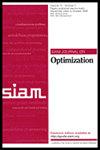Nonasymptotic Upper Estimates for Errors of the Sample Average Approximation Method to Solve Risk-Averse Stochastic Programs
IF 2.3
1区 数学
Q1 MATHEMATICS, APPLIED
引用次数: 0
Abstract
SIAM Journal on Optimization, Volume 34, Issue 2, Page 1264-1294, June 2024.Abstract. We study statistical properties of the optimal value of the sample average approximation (SAA). The focus is on the tail function of the absolute error induced by the SAA, deriving upper estimates of its outcomes dependent on the sample size. The estimates allow to conclude immediately convergence rates for the optimal value of the SAA. As a crucial point, the investigations are based on new types of conditions from the theory of empirical processes which do not rely on pathwise analytical properties of the goal functions. In particular, continuity in the parameter is not imposed in advance as often in the literature on the SAA method. It is also shown that the new condition is satisfied if the paths of the goal functions are Hölder continuous so that the main results carry over in this case. Moreover, the main results are applied to goal functions whose paths are piecewise Hölder continuous as, e.g., in two-stage mixed-integer programs. The main results are shown for classical risk-neutral stochastic programs, but we also demonstrate how to apply them to the sample average approximation of risk-averse stochastic programs. In this respect, we consider stochastic programs expressed in terms of mean upper semideviations and divergence risk measures.
解决风险厌恶随机程序的样本平均逼近法误差的非渐近上限估计值
SIAM 优化期刊》,第 34 卷第 2 期,第 1264-1294 页,2024 年 6 月。 摘要我们研究了样本平均近似(SAA)最优值的统计特性。重点是 SAA 引起的绝对误差的尾函数,推导出其结果取决于样本大小的上限估计值。通过这些估计值,可以立即得出 SAA 最佳值的收敛率。关键的一点是,研究基于经验过程理论中的新型条件,而这些条件并不依赖于目标函数的路径分析特性。特别是,没有像有关 SAA 方法的文献中经常提到的那样,事先强加参数的连续性。研究还表明,如果目标函数的路径是荷尔德连续的,那么新条件就会得到满足,因此主要结果在这种情况下也是如此。此外,主要结果还适用于路径为片断荷尔德连续的目标函数,例如两阶段混合整数程序。主要结果针对经典的风险中性随机程序,但我们也演示了如何将它们应用于风险规避随机程序的样本平均近似。在这方面,我们考虑了用均值上半偏差和发散风险度量表示的随机程序。
本文章由计算机程序翻译,如有差异,请以英文原文为准。
求助全文
约1分钟内获得全文
求助全文
来源期刊

SIAM Journal on Optimization
数学-应用数学
CiteScore
5.30
自引率
9.70%
发文量
101
审稿时长
6-12 weeks
期刊介绍:
The SIAM Journal on Optimization contains research articles on the theory and practice of optimization. The areas addressed include linear and quadratic programming, convex programming, nonlinear programming, complementarity problems, stochastic optimization, combinatorial optimization, integer programming, and convex, nonsmooth and variational analysis. Contributions may emphasize optimization theory, algorithms, software, computational practice, applications, or the links between these subjects.
 求助内容:
求助内容: 应助结果提醒方式:
应助结果提醒方式:


